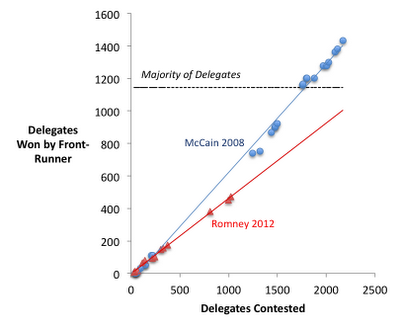This is the website of Abulsme Noibatno Itramne (also known as Sam Minter).
Posts here are rare these days. For current stuff, follow me on Mastodon
|
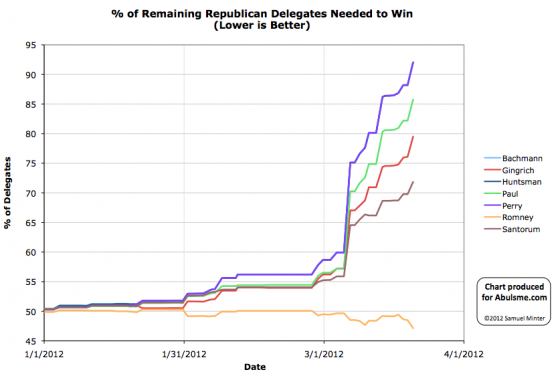 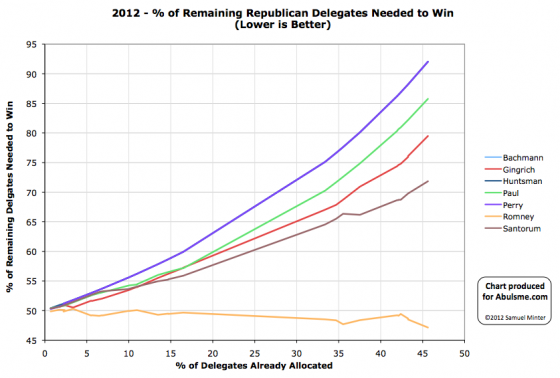
Charts from the Abulsme.com 2012 Republican Delegate Count Graphs page. When a candidate gets down to 0%, they have cinched the nomination. If they get up past 100%, they have been mathematically eliminated. The first chart is by date, on the second chart rather than the date on the x-axis, we show the “% of Delegates Already Allocated” as this better represents the progress through the race. Note that these numbers include estimates of the eventual results of multi-stage caucus processes which will be refined as the later stages occur.
So this looks like it might be it. As I indicated might be a possibility in yesterday’s update, between Romney’s lead growing rapidly in recent polls and Santorum failing to file proper delegate slates everywhere, Romney did indeed do well enough to be moving in the direction of getting to 1144. (In fact he blew away the percentages he needed to get for that.) He is now in the best position he has been in since the race began, and the chances of any brokered convention shenanigans are receding quickly.
Lets look at the specifics.
With 99% of precincts reporting, Romney has 46.7% of the popular vote in Illinois. But because of the specifics of how delegates are allocated, and Santorum’s failure to have delegate slates everywhere, this translates into getting 42 of the 54 delegates that were up for grabs tonight. That is 77.8% of the delegates. WELL above the 48.5% of delegates he needed to improve his position overall.
Santorum gets the other 12 delegates allocated tonight. Gingrich and Paul are shut out and get nothing.
Also today the one Puerto Rican superdelegate who had previously endorsed Gingrich decides to echo the election results there, says it is “time to unite” and switches his endorsement to Romney.
This makes the totals for today: Romney +43, Santorum +12, Gingrich -1
And looking at “% of remaining delegates needed to win”:
- Romney: 48.5% -> 47.1%
- Santorum: 69.8% -> 71.8%
- Gingrich: 76.1% -> 79.5%
- Paul: 82.2% -> 85.8%
Looking at the charts at the top of this post, between Puerto Rico and Illinois, Romney is finally starting to really drive down this number. His line is finally starting to move downward rapidly. The three non-Romneys continue their race toward mathematical elimination. It won’t be long now.
How about the possibilities for blocking Romney? Well, at this point the combined non-Romneys would need to consistently get 52.9% of the remaining delegates in order to be on a pace to stop Romney from getting to 1144. Up to this point the non-Romney’s have managed 46.5% of the delegates. Making the jump from 47% to 53% is a big jump, but still not an unimaginable jump. Perhaps with a few major Romney stumbles in a row? And a few good states in a row? Louisiana maybe? The RCP average for Louisiana has the non-Romneys at 56%. If the popular vote ends up like that, and the delegates parallel the popular vote…
Well, yes, Romney may not get what he needs in Louisiana. But after that the calendar starts looking better for Romney again. And with it being essentially 100% clear at this point that none of the non-Romneys have a chance at 1144 (despite what Santorum’s camp was saying recently) and it is all just about blocking Romney, do people continue to vote for candidates who are clearly losing? And perhaps just as importantly, do rich donors still throw millions at candidates who clearly are going nowhere? Probably not.
It has taken awhile, but it really does look like Romney is finally starting to put the chances of being blocked in the rear view mirror. I’m not ready to call it impossible quite yet. But it is getting closer to that point and is already very unlikely. We can already say that the non-Romney’s getting it together enough to block Romney would require a major change to how they’ve been doing so far, and a reversal of recent trends.
Once Romney’s “% of remaining needed to win” drops below 45% or so we can pretty safely call this a done deal absent a major catastrophe. From then on out, it will just be Romney slowly but surely grinding his way to 1144. But we aren’t there quite yet.
Lets see how Louisiana, DC, Maryland and Wisconsin go. (Those last three are winner take all, so April 3rd will be a big day!)
This of course does mean that Santorum is now the frontrunner to be the 2016 Republican nominee. (Since Romney will lose to Obama in November according to current polling, and by coming in 2nd this time around, Santorum would be “next in line” on the Republican side.)
Too soon?
The following was also posted as a series of comments both on the last post here and on the Enik Rising blog, but I thought it was worth repeating as a full fledged post as well, because it helps interpret the graphs in the last post more intelligently. Bottom line, the % vs Absolute difference didn’t make a big difference in the two charts, our underlying data was nearly the same, but some minor differences made the two charts appear to give entirely different conclusions. I’ll post a revised chart once we get past Louisiana.
Anyway, the comments…
First, I commented on Enik Rising with a link to my last post. Seth replied in the comments with:
Thanks for noticing my error! I’ve added a new chart above, although it looks virtually identical to my previous one. I assume the big difference comes from the different methods of determining delegate shares.
March 20, 2012 8:58 AM
The addition to his earlier post was:
Update: Samuel Minter makes the very important observation that there are different total numbers of Republican delegates in 2008 and 2012, making a direct comparison of raw delegate counts misleading. I don’t have a good excuse here. Anyway, I went ahead a changed the raw counts to percentages and produced… almost exactly the same chart:
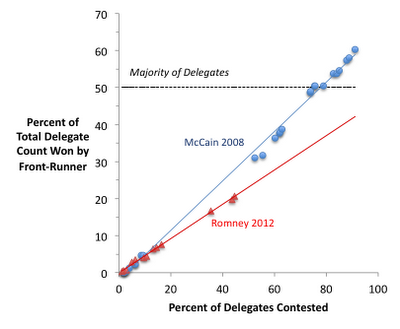
I’m not really sure why his chart looks so different from mine. Perhaps it’s because he’s using Green Paper numbers rather than RCP numbers, perhaps because I use a linear projection and he doesn’t….
So of course I had to dig deeper. At first I was sure it was just different sources doing delegate counts differently. Then I was sure it was the 2008 results being complete results that came later dated back to the original primary/caucus dates vs incomplete results now. Both of those were incorrect. When you actually look at the data points on the two charts, they actually match up very nicely.
The TL;DR: The data points in my chart and his chart actually line up quite nicely. But….
- I have some extra points due to partial results from Super Tuesday before things were final that show McCain closer to Romney at the percentage we are right now. This keeps the two lines closer together for longer.
- The line he draws for Romney has the slope increased due to the fact it contains many post-Super Tuesday points… the time during which McCain had wrapped it up and started getting delegates at a faster pace.
- My chart is wider than it is tall, while his is taller than it is wide, so the same vertical difference between lines looks greater on his charts.
These three things fully account for looking at these two charts and seeing two different things even though the underlying data is very nearly the same.
So here is what I posted in the comments on Enik Rising as I was figuring it out:
Thanks for taking a look Seth. Lets try to figure out why the two charts look different.
The source counts are different of course, but not by much, at least for 2012. RCP has Romney at 516 delegates right now (22.6% with 42.0% determined), Green Papers has him at 515 (22.5% with 43.3% determined). So Green Papers actually has the Romney 2012 line LOWER than you would get with RCP, but they are pretty close.
It must be the 2008 numbers that differ between the sources then. RCP’s line must be much higher than the line I got from tracking CNN in 2008.
Looks like on the 2008 line you have a data point at about (60%,37%). My data taken daily from CNN back in 2008 had 60% being hit on February 20th. At that point the count was McCain 918 out of the 2380 delegates, or 38%. So… almost the same place you have your data point. It looks like our data points around the 50% mark in 2008 line up pretty well too.
Hmmm…
Ah! I know now. I have a few additional data points that come from the days right after super Tuesday since those results came in over the course of a few days and I took snapshots of the count every day, rather than just having the final results as if they were immediately known on Super Tuesday. I have additional data points other places as well due to more intermediate results.
So I have more data points right around the percentage we are at right now, whereas on your chart right now Romney is in the gap caused by Super Tuesday and the next data point for McCain is the one with complete 2008 results. And it looks like those initial delegate results I have filling in that gap were slightly less favorable to McCain than the results that came in more slowly over the next couple of days. (My spreadsheet is linked on my wiki, feel free to look through the details.)
Then the rest of your data points are AFTER Super Tuesday. But of course after Super Tuesday McCain started accelerating because he was the presumptive nominee and so started collecting delegates faster at that point. Both your linear trend line and what the eye is drawn to for the data points, picks up on that accelerated post-Super Tuesday velocity and thus pulls the trend line to a higher slope.
Between these two things (my additional data points for partial super Tuesday results and McCain acceleration after passing the 52% mark) I think we completely explain the difference between the two charts.
March 20, 2012 1:43 PM
And then in a follow up… (Well, OK, I had to split it into two comments because I was unnecessarily long winded and it was too long for one comment… I could have edited it down to the TL;DR above before posting it as a comment, but I didn’t… Oops.)
From SM via Enik Rising:
The place where that “kink” happened and McCain started accelerating happened immediately post Super Tuesday. In 2008 once all the Super Tuesday results were in, the delegates awarded so far percentage was at just about 52%. This is about where we will be this time around right after Louisiana on Saturday.
So if we both redraw our graphs when we add the data points for Illinois and for Louisiana, we should see our data points for the 52% mark line up much more closely with each other again, and we’ll be looking at a comparison with data points close to the same percentages again (as opposed to Romney currently being in the “Super Tuesday gap” when compared to 2008).
At that point I think we’ll have a clear picture of how far behind McCain’s pace Romney really is at the moment. Right now the big 2008 Super Tuesday gap makes the comparison very dependent on small details of the analysis.
After Louisiana we’ll be able to compare 2012 at 52%, with 2008 at 52% and have a real apples to apples comparison.
So what would it take for Romney to catch up with where McCain was at the 52% mark? Lets do that math really quickly… To catch up Romney would need to hit the 30% of total delegates mark… or 686 delegates. That is a gain of 171 delegates. There are only 115 delegates between Illinois and Louisiana, and not all of them will be determined this week, and Romney won’t be getting 100% of them anyway, so that clearly isn’t happening.
Romney will be behind McCain’s pace no matter what, the only question will be by how much. My charts will start to show Romney falling behind McCain too at that point.
(And more relevantly for this time around, is he able to get enough to be on pace for 1144, or do we get brokered convention talk getting louder and louder in volume….)
Anyway, mystery solved. I think. :-)
March 20, 2012 1:43 PM
And then I thought of the aspect ratio thing:
I know, too long already, but thought of one other factor. My chart is wider than they are tall, where yours is taller than it is wide. This means the same vertical difference on both charts will look larger on your chart.
Between these three things, the difference in perception of the two charts is fully explained, even though the underlying data is essentially the same.
Anyway… Illinois. :-)
March 20, 2012 8:25 PM
Moral of the story… little details matter in charts like this, and can greatly affect the conclusions you draw from looking at them.
I had previously talked about the comparisons between the 2012 and 2008 Republican races here, here and here. The last of those is the most relevant, and if you haven’t checked it out before, feel free to go back and do so now. :-)
In any case, a few hours ago I saw this tweet from @DemConWatch. It links to the article below. I’ve quoted the key conclusion, but please click through and read the whole thing.
Romney, McCain, and the long slog to 1,144
(Seth, Enik Rising, 2012 Mar 19)
Below, I’ve charted McCain’s and Romney’s delegate shares compared to the total number of delegates that have been awarded to date. So, for example, by the time 1,247 delegates had been awarded in 2008 (Super Tuesday), McCain had won 740 of them. (I’ve used RCP’s estimates of delegate shares in 2008 and 2012.) I’ve projected a linear path for both years.
So the big thing to note here is that Romney is accumulating delegates at a slower pace than McCain did four years ago. Also of note: Romney will not get to 1,144 delegates (a majority) by the end of the primaries and caucuses assuming he keeps accumulating delegates at his current pace.
The thing I immediately noticed… the total number of delegates was different in 2008 and 2012! In 2008 there were 2380 delegates total. In 2012 there are only 2286! So using absolute numbers of delegates on the axes is not doing a direct comparison. You need to look at these as percentages of the total number of delegates available.
So I redid the chart on that basis, using the data I had collected in my 2008 Delegate Race Page (which used CNN’s delegate counts, grabbed and put into a spreadsheet on a daily basis) and which I am now collecting in my 2012 Delegate Race Page (which uses the Soft Count from Greenpapers including DCW’s Superdelegate numbers also grabbed daily for a spreadsheet).
Now, both my 2012 and 2008 numbers include so called “fantasy delegates” projecting the eventual results from caucus states, etc, which many folks argue is not the right way to track delegates, but since both years followed that practice, it seems like a valid comparison.
In any case, the result is this:
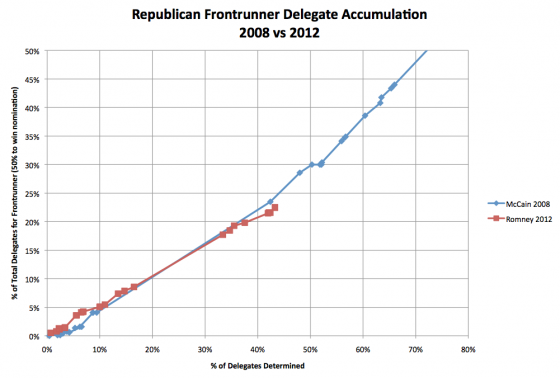
Romney is indeed behind McCain’s pace, but only very slightly, and that only developed in the last few contests. For most of the race so far, the pace of the two candidates tracked very closely, with Romney actually being ahead of McCain’s pace until Super Tuesday. He certainly is not as far behind as he appeared in Seth’s chart from Enik Rising. Rather, once you correct for both the calendar changes and the differing number of delegates, we see that the whole narrative of Romney being much slower to wrap things up than McCain was four years ago just falls apart.
I’ll note that using the Green Papers count instead of the RCP Count that Seth used puts Romney slightly BETTER than the pace he needs to get to 1144 rather than slightly worse than that pace. And indeed, which sources you use for both the 2008 and 2012 delegate counts probably matters here. Given how much the various estimates vary I imagine how far the two lines are from each other may be quite different based on which delegate counts you use… but the above is what I get using the sources I chose to use for tracking in these two cycles.
I’ll also use this opportunity to update the comparison between 2008 and 2012 using the metric I prefer… “% of remaining delegates needed to win”. This hits 100% once a candidate is mathematically eliminated or hits 0% once they have the needed number of delegates to secure the nomination.
In 2008 on the Republican side the chart of this number for the various candidates looked like this:
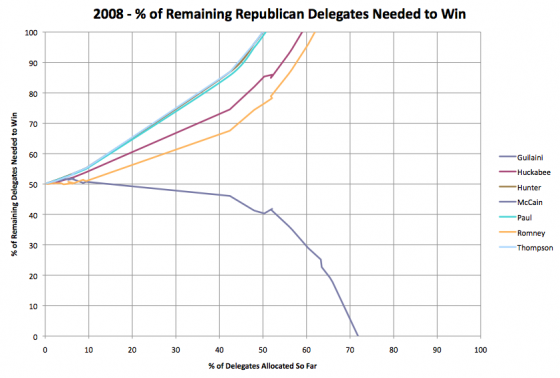
As of right now in 2012 (a few hours before the March 20th Illinois primary) this looks like this:
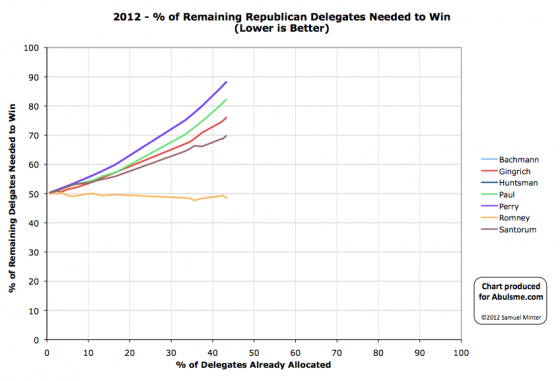
Comparing these, as with the other chart, you can see that McCain in 2008 was indeed a bit better off at this point than Romney is this time around, but not by a huge margin.
Using the sources I noted above, as of today 43.3% of the delegates have been allocated (or at least estimated in the case of those pesky fantasy delegates). As of today Romney needs 48.5% of the remaining delegates to wrap up the nomination.
The closest equivalent day in 2008 would have been February 6th 2008 (just after Super Tuesday, with incomplete delegate results from those contests as results trickled in over several days) with 42.4% of the delegates determined (or estimated). At that point McCain needed 46.1% of the remaining delegates to win. Unquestionably better than Romney today, just not by a HUGE margin yet.
In any case, the massive perception difference in terms of how well Romney is “wrapping it up” in 2012 compared to McCain in 2008 is almost all due to the spread out calendar. In reality, Romney is actually only a little bit behind McCain’s pace four years ago. It just SEEMS like he is much much further behind due to the fact it is the end of March at this point rather than the beginning of February which is when we were at the equivalent point in the delegate race back in 2008.
Finally, just for an additional comparison, here is the same graph for the Democrats in 2008…
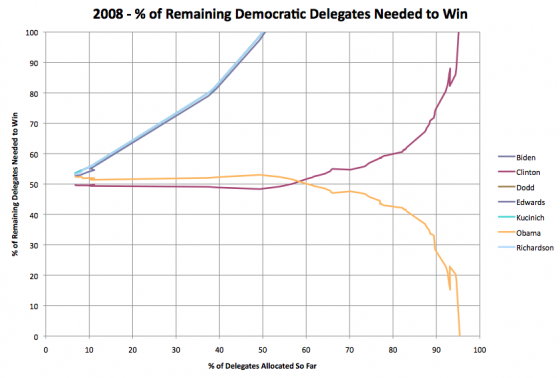
(Minor wording edits and fixes were made in the 90 minutes or so after posting.)
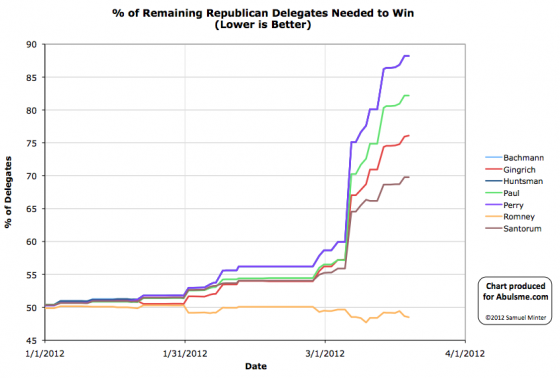
Chart from the Abulsme.com 2012 Republican Delegate Count Graphs page. When a candidate gets down to 0%, they have cinched the nomination. If they get up past 100%, they have been mathematically eliminated. Note that these numbers include estimates of the eventual results of multi-stage caucus processes which will be refined as the later stages occur.
A minor update from Georgia today. My primary source, Green Papers, previously had the results from Georgia as Gingrich 54, Romney 19, Santorum 3. This has now been updated to Gingrich 52, Romney 21, Santorum 3.
So the net for the day is Romney +2, Gingrich -2.
So Romney’s “% of remaining needed to win” drops from 48.7% to 48.5%. (And Gingrich’s rises from 75.9% to 76.1%.)
This is a minor change that does not change the state of the race significantly. But since there is an update today, it gives me a chance to modify something I said in the last update based on new information. I had said:
Next up is Illinois. Romney is ahead in the polls in Illinois, but isn’t over 48.7% in those polls, and of course nobody else is close to the numbers above either. The contest there is a “Loophole Primary” which is a bit odd, but if the delegate results are even close to being proportional to the popular vote result, then we can expect Illinois to be another of the “everybody loses” states where nobody actually gets closer to the nomination in terms of being on pace to win.
Well. two things.
First, recent polls have been moving in Romney’s direction over the last week. The most recent poll as of this writing was a poll from PPP (pdf) that has Romney at 45%. Now, polls predict popular vote, not delegates, and the 48.5% Romney needs is a percentage of delegates, not a percentage of the popular vote. But assuming at least some correlation between popular vote and delegates, those numbers are getting pretty close to each other. Which brings us to…
Second, Santorum failed to properly file for delegate slates in some parts of the state. This means that Santorum’s delegate take will almost certainly underperform his performance in the popular vote. This implies that Romney’s delegate take may well overperform his popular vote number.
With these two factors together, Romney’s chances of getting to the 48.5% he needs to improve his “% of remaining” number and move closer to the nomination and further away from the scenarios where he doesn’t get to 1144 is much more likely than it looked previously.
By this time tomorrow, we should know how that turned out.
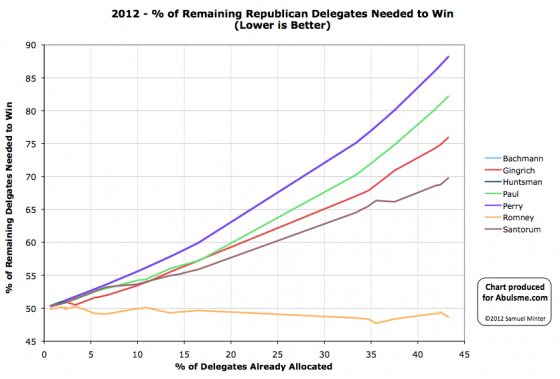
Chart from the Abulsme.com 2012 Republican Delegate Count Graphs page. When a candidate gets down to 0%, they have cinched the nomination. If they get up past 100%, they have been mathematically eliminated. Rather than the date on the x-axis, we show the “% of Delegates Already Allocated” as this better represents the progress through the race. Note that these numbers include estimates of the eventual results of multi-stage caucus processes which will be refined as the later stages occur.
So. Puerto Rico. Romney wins by a huge margin. He got more than 80% of the vote. In second place Santorum got less than 10% of the vote. 50% was the magic number though. The rules for Puerto Rico said that if the winner gets more than 50%, then the delegates are allocated winner take all. So Romney gets all 20 regular delegates from Puerto Rico. (Romney already had 2 of the 3 super delegates from Puerto Rico before tonight, with Gingrich having the remaining super delegate.)
Obviously getting 100% of today’s delegates is good for Romney, and bad for everybody else. Duh. Romney’s best position so far was still on March 10th, right after Guam and the Northern Marianas results, but before Kansas and the Virgin Islands. But he moves back toward the nomination, and away from the possibility of not getting to 1144 with this result. The others continue on their rapid path toward mathematical elimination. In terms of the magical “% of remaining delegates needed to win” number:
- Romney: 49.4% -> 48.7%
- Santorum: 68.7% -> 69.8%
- Gingrich: 74.8% -> 75.9%
- Paul: 80.9% -> 82.2%
Next up is Illinois. Romney is ahead in the polls in Illinois, but isn’t over 48.7% in those polls, and of course nobody else is close to the numbers above either. The contest there is a “Loophole Primary” which is a bit odd, but if the delegate results are even close to being proportional to the popular vote result, then we can expect Illinois to be another of the “everybody loses” states where nobody actually gets closer to the nomination in terms of being on pace to win.
Add that to Louisiana, which will almost certainly also be an “everybody loses” state and we should wrap up the March contests with basically the same situation we have right now… the 3-non Romney’s with no chance of winning, but Romney still in the zone where being blocked from 1144 is very much still within the realm of possibility.
And then we’ll have April.
One thing to watch… does Romney remain in the zone where his “% of remaining needed to win” is less than the “% of delegates so far” number. If so, then continuing at the same pace will eventually get him to 1144, just really slowly. If not, then he’ll actually not be on a winning pace, and will have to actually improve his delegate collection rate to win. (Right now Romney has 51.9% of the delegates so far, compared to needing only 48.7% of the remaining delegates to win.)
| In the latest Curmudgeon’s Corner…
Sam and Ivan talk about:
- Election 2012
- New iPad Launch
- Iran / Syria
- TAL Retraction
Just click to listen now:
[wpaudio url=”http://www.abulsme.com/CurmudgeonsCorner/cc20120318.mp3″ text=”Recorded 18 Mar 2012″]
or
 1-Click Subscribe in iTunes 1-Click Subscribe in iTunes
 View Podcast in iTunes View Podcast in iTunes
 View XML Feed View XML Feed
|
 |
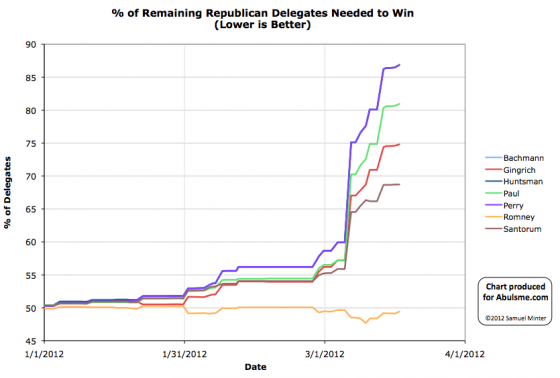
Chart from the Abulsme.com 2012 Republican Delegate Count Graphs page. When a candidate gets down to 0%, they have cinched the nomination. If they get up past 100%, they have been mathematically eliminated. Note that these numbers include estimates of the eventual results of multi-stage caucus processes which will be refined as the later stages occur.
Looks like we finally have final results for all the delegates from Alabama, and what will (maybe?) be a final update for Hawaii as well. All of this from Green Papers of course.
In Alabama we add 4 more delegates for Santorum and 2 more for Gingrich. This brings the total for non-Super delegates in Alabama to 22 Santorum, 14 Gingrich, 11 Romney. (Santorum also has one of the three superdelegates for the state, the other two haven’t endorsed yet.)
In Hawaii, the update we listed on March 15th is reversed. At that time a delegate was removed from the Paul column and given to Romney. Today that delegate appears to go back into the Paul column. This leaves Hawaii at 9 Romney, 5 Santorum, 3 Paul. So +1 Paul, -1 Romney.
So the net for today’s update: Santorum +4, Gingrich +2, Paul +1, Romney -1.
This gives changes for the “% of remaining needed to win” number as follows:
- Romney: 49.13% -> 49.43%
- Santorum: 68.71% -> 68.72%
- Gingrich: 74.60% -> 74.79%
- Paul: 80.65% -> 80.94%
Notice that everybody goes up. This is a small number of delegates of course, and pretty small changes to the numbers, but nobody here actually improved their position in terms of being able to get to 1144. Of the net 6 new delegates today, Santorum got 4. So 66.67%. Which is quite a healthy percentage. Overwhelmingly wins the day. But he would have had to have done even better to actually be on a pace to catch up with Romney. Lots of splits like this lead toward nobody getting 1144.
But this was a minor update day with a small number of delegates. We’ll see what the real contests get us over the coming week.
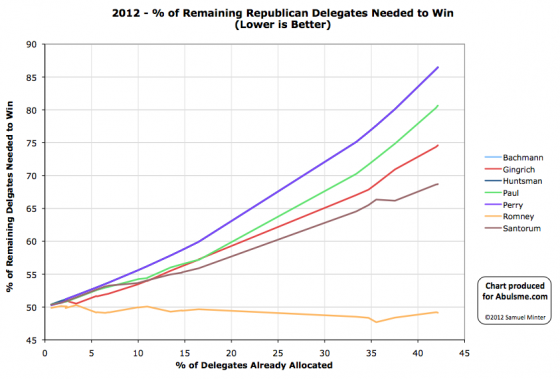
Chart from the Abulsme.com 2012 Republican Delegate Count Graphs page. When a candidate gets down to 0%, they have cinched the nomination. If they get up past 100%, they have been mathematically eliminated. Rather than the date on the x-axis, we show the “% of Delegates Already Allocated” as this better represents the progress through the race. Note that these numbers include estimates of the eventual results of multi-stage caucus processes which will be refined as the later stages occur.
Very minor update today. One new superdelegate from Indiana endorsed Romney. You can barely see the effect on the charts with a microscope. If one must look, Romney’s “% of remaining needed to win” drops from 49.17% to 49.13%. Santorum’s rises from 68.66% to 68.71%. At this stage, one delegate barely budges the numbers.
So we await Puerto Rico this weekend for the next big batch of delegates.
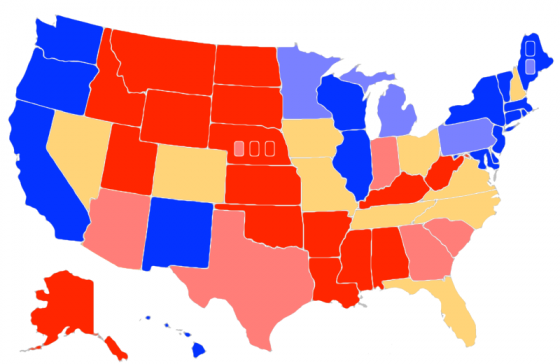
Map from the Abulsme.com 2012 Electoral College Prediction page. This map reflects Obama vs Romney. If any other candidate takes the lead in the Republican delegate race we’ll switch to making maps for them. This reflects the current state of polling, which of course will change drastically as the campaign progresses from now until November.
The latest update in my five poll averages puts Romney’s lead in Arizona over 5%, so the state moves out of the “Lean Romney” swing state status to “Weak Romney” indicating Romney’s lead is more than 5% but less than 10%. This moves Arizona out of the list of states that could easily go either way, and reduces the margin in Obama’s “Best Case” Scenario.
|
Romney |
Obama |
| Romney Best Case |
291 |
247 |
| Current Status |
210 |
328 |
| Obama Best Case |
170 |
368 |
And the trends over time…
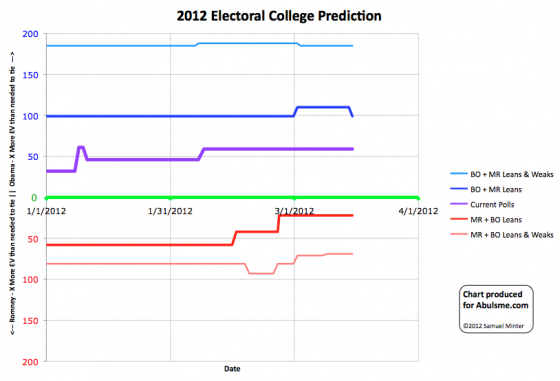
Chart from the Abulsme.com 2012 Electoral College Prediction page. Lines represent how many more electoral votes a candidate has than is needed to tie under several different scenarios. This chart reflects Obama vs Romney. Lines moving up indicate Obama’s situation improving, lines moving down indicate Romney’s situation improving. If any other candidate takes the lead in the Republican delegate race we’ll switch to making charts for them.
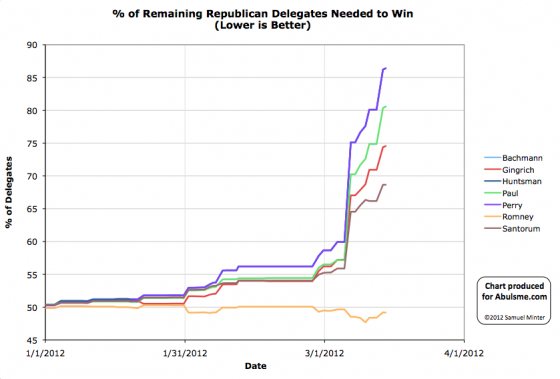
Chart from the Abulsme.com 2012 Republican Delegate Count Graphs page. When a candidate gets down to 0%, they have cinched the nomination. If they get up past 100%, they have been mathematically eliminated. Note that these numbers include estimates of the eventual results of multi-stage caucus processes which will be refined as the later stages occur.
Some minor updates today as results get finalized in the last round of states. In Alabama 3 of the 9 non-super delegates that Green Papers still had as TBD have been determined… 2 for Santorum, 1 for Romney. Meanwhile, in Hawaii the Green Papers estimate gets revised from 9 Romney, 5 Santorum, 3 Paul to 10 Romney, 5 Santorum, 2 Paul. So in Hawaii +1 for Romney, -1 for Paul.
Net for the day: +2 Romney, +2 Santorum, -1 Paul
There are still 6 non-super delegates in Alabama in the TBD category, so we haven’t heard the last from Alabama.
Since this is only a very small number of delegates, the effects are very small. In terms of “% of remaining needed to win”:
- Romney: 49.21% -> 49.17%
- Santorum: 68.65% -> 68.66%
- Gingrich: 74.38% -> 74.55%
- Paul: 80.33% -> 80.59%
Obviously this changes nothing at all about the analysis of the state of the race that was presented yesterday.
|
|



